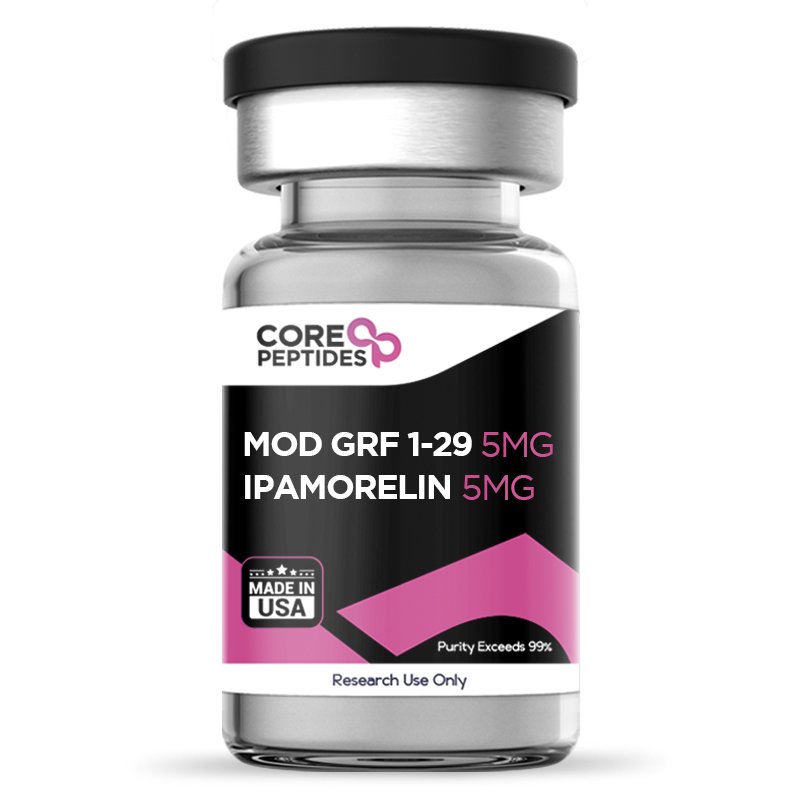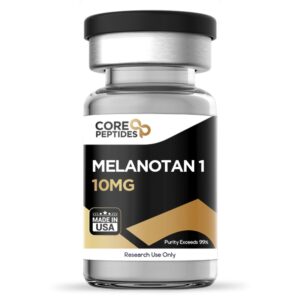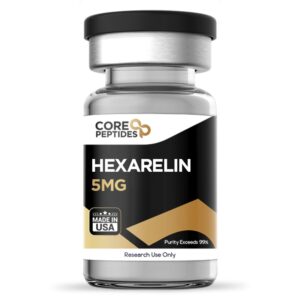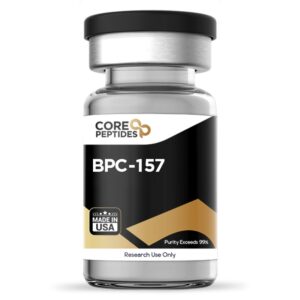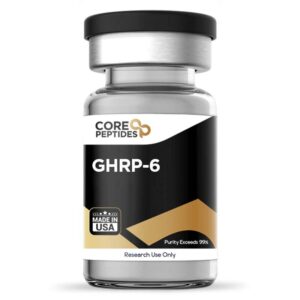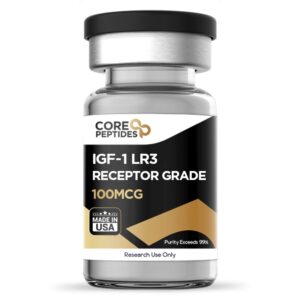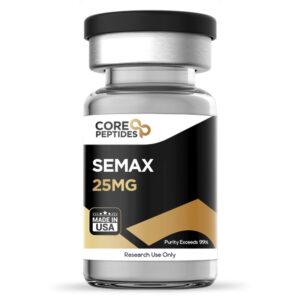Mod GRF 1-29 & Ipamorelin Blend (10mg)
$84.00
Size: 10mg
Contents: Mod GRF 1-29 (5mg) & Ipamorelin (5mg)
Form: Lyophilized powder
Purity: >99%
SKU: P-MODGRFIPAM-10
FREE Shipping on $200+ orders
Discount per Quantity
| Quantity | Discount | Price |
|---|---|---|
| 5 - 8 | 5% | $79.80 |
| 9 + | 10% | $75.60 |
Mod GRF 1-29 & Ipamorelin Peptide Blend
The Ipamorelin peptide has been studied for its potential as a growth hormone secretagogue (GHS). This synthetic pentapeptide is thought to operate in a manner akin to Growth Hormone Releasing Peptides (GHRPs) and may simulate the natural action of the hunger hormone, ghrelin. Specifically, it is believed that Ipamorelin may activate ghrelin receptors in the anterior pituitary gland, also known as Growth Hormone Secretagogue Receptors 1 Alpha (GHS-R1a). This makes it a notably selective secretagogue and a strong agonist for the growth hormone/ghrelin secretagogue receptor.
What sets Ipamorelin apart is its selectivity, as it does not appear to influence the release of other hormones from the pituitary gland, such as prolactin, follicle-stimulating hormone (FSH), luteinizing hormone (LH), thyroid-stimulating hormone (TSH), or Adrenocorticotropic hormone (ACTH). Modified GRF (1-29) peptide, also known as Mod GRF 1-29, is a synthetic analog of natural growth hormone-releasing hormone (GHRH). Comprising the initial 29 amino acids of the native hormone, this analog appears to stimulate GHRH receptors located in the somatotroph cells of the anterior pituitary gland, thereby facilitating the release of growth hormone. While it shares structural similarities with GRF 1-29, Mod GRF 1-29 has been slightly altered by replacing four amino acids in its original sequence. These adjustments seem to improve the peptide's pharmacokinetic properties. When presented together as a blend, these peptides appear to yield synergistic results, possibly stimulating the pituitary gland and triggering the release of growth hormone.
Chemical Makeup (1)(2)(3)
Molecular Formula:
- Modified GRF 1-29: C152H252N44O42
- Ipamorelin: C38H49N9O5
Molecular Weight:
- Modified GRF 1-29: 3367.95 g/mol
- Ipamorelin: 711.86 g/mol
Other Known Titles
- Modified GRF 1-29: Mod GRF 1-29, CJC-1295 without DAC
- Ipamorelin: Ipamorelin Acetate, Aib-His-D-2-Nal-D-Phe-Lys-NH2
Research and Clinical Studies
Mod GRF 1-29 & Ipamorelin Blend General Research
A 1998 study(4) was carried out where these growth hormone secretagogues were presented in the rat pituitary gland as well as in anesthetized rats and conscious swine. Results of all three studies suggested that these peptides are agonists of GHRP-like receptors, as they bind to these receptors and help secrete higher concentrations of growth hormone. While some growth hormone secretagogues also appeared to trigger increased levels of other hormones such as cortisol and ACTH, Ipamorelin and Modified GRF 1-29 peptides appeared to exhibit selectivity towards growth hormones only, suggesting that these peptides may be particular in their functions.
In one 1999 clinical study,(5) eight test subjects were enrolled to examine the potential of growth hormone secretagogues at different concentrations. The concentrations were increased every 15 minutes for up to two hours. After the study was completed, the concentration of growth hormones appeared to have significantly risen throughout the study period.
Mod GRF 1-29 & Ipamorelin Blend and Potency
In this preliminary study,(6) experimental rats were examined after being introduced to GHRH peptide analogs such as Modified GRF 1-29 peptide. The results suggested that the peptide may be considerably more potent than regular GRF 1-29.
Mod GRF 1-29 & Ipamorelin Blend and the Pituitary
When Mod GRF 1-29 interacts with GHRH receptors on the somatotroph cells of the anterior pituitary gland, it is theorized to act as a catalyst for ensuing cellular activities that may contribute to the release of growth hormone. This interaction is thought to set off a chain of intracellular signaling events. One such signaling route that seems to be engaged is the adenylyl cyclase pathway, potentially leading to the transformation of ATP (adenosine triphosphate) into cAMP (cyclic adenosine monophosphate).(7) The subsequent elevation in cAMP levels is speculated to activate protein kinase A (PKA), which in turn may result in the phosphorylation of various proteins. Among these proteins are the voltage-dependent calcium channels located on the cell membrane. The phosphorylation of these channels is conjectured to facilitate the influx of calcium ions into the somatotrophic cells. Elevated levels of intracellular calcium are considered to be a key factor in the subsequent stages that may lead to growth hormone release. It is further theorized that these high calcium concentrations within the cell could prompt the secretory vesicles in the somatotroph cells to release growth hormone into the bloodstream.
It seems that Ipamorelin may also engage with cells in the front part of the pituitary gland by targeting the N-terminal region of GHS-R1a. This region contains specific binding sites that are likely sensitive to particular sequences in the secretagogue. When Ipamorelin encounters this receptor, it may form a temporary bond, facilitated by hydrogen bonds and van der Waals interactions. This transient bonding may induce a conformational change in the receptor, potentially triggering intracellular signaling pathways, predominantly those associated with G-proteins.(8) Specifically, GHS-R1a is thought to collaborate with a specialized subunit of G-proteins known as Gαq/11. Gαq/11 is believed to interact with PLC, which may then cleave a lipid molecule called phosphatidylinositol 4,5-bisphosphate (PIP2) into two secondary messengers: IP3 (Inositol trisphosphate) and DAG (Diacylglycerol). IP3 may bind to specific sites on an organelle known as the endoplasmic reticulum, possibly leading to the release of calcium ions (Ca2+) and activation of proteins that facilitate the secretion of growth hormone from pituitary cells.(9)
Mod GRF 1-29 & Ipamorelin Blend and the Gastrointestinal System
In a particular study, scientists explored how Ipamorelin might influence gastric function, specifically focusing on its potential to accelerate gastric emptying. They used a specialized method to measure gastric emptying, which involves tracking the percentage of radioactivity remaining in the stomach 15 minutes after introducing a specific substance via intragastric gavage. The team noted that the surgical procedures performed on the abdomen could have contributed to a slower rate of gastric emptying, especially evident in the control group that received a vehicle substance. Contrastingly, Ipamorelin seemed to significantly hasten the emptying process when compared to the control group. This led the researchers to consider the possibility that Ipamorelin could enhance the speed of gastric emptying. Further investigations were carried out to understand the compound's impact on the contractile behavior of gastric smooth muscles, which were stimulated by acetylcholine and electrical field stimulation. The findings indicated that surgical intervention and manipulation of the intestines might substantially suppress the contractile responses of these muscles to both stimuli. Interestingly, this suppression appeared to be counteracted when both Ipamorelin and ghrelin were introduced together. This raises the speculative notion that Ipamorelin may not only stimulate the contractility of gastric smooth muscles but also potentially negate the inhibitory action induced by certain surgical procedures.(10)
Mod GRF 1-29 & Ipamorelin Blend and Appetite
The potential impact of Ipamorelin on ghrelin receptors suggests it may possibly boost appetite and, maybe, contribute to weight gain. A study indicates that experimental subjects experienced an approximate 15% increase in body weight when exposed to Ipamorelin.(11) Researchers theorize that this compound may have proportionally increased fat pad weights relative to overall body mass.(11) As a result, dual-energy X-ray absorptiometry (DEXA) measurements may show a relative uptick in body fat. Additionally, data suggests that Ipamorelin may have raised levels of serum leptin, a hormone implicated in regulating energy and appetite. This leads scientists to hypothesize that increased food intake may be a factor in the observed weight gain among the Ipamorelin groups. They commented that “GHSs increase body fat by GH-independent mechanisms that may include increased feeding.”
Mod GRF 1-29 & Ipamorelin Blend and Bone Density
In a study involving murine models, Ipamorelin and a control substance were introduced to assess their potential on bone mass. Real-time DEXA was employed to monitor changes in bone mineral content, focusing on specific regions like the femur and L6 vertebrae. After the research period, mid-diaphyseal peripheral quantitative computed tomography (pQCT) scans were conducted on the femurs of the subjects. Initial findings indicate that Ipamorelin may be linked to a potential increase in weight as well as a possible uptick in bone mineral content in the tibia and vertebrae, as revealed by DEXA, when compared to the control group. Moreover, pQCT data suggests that the observed rise in cortical BMC may be attributable to an enlargement in the bone's cross-sectional area.(12) The researchers also posited that “small stimulatory effects on linear bone growth may not have been detected statistically in the GH- and ipamorelin-treated groups,”
Mod GRF 1-29 & Ipamorelin Blend is available for research and laboratory purposes only. Please review and adhere to our Terms and Conditions before ordering.
References
- National Center for Biotechnology Information (2023). PubChem Compound Summary for CID 91976842, CJC1295 Without DAC. https://pubchem.ncbi.nlm.nih.gov/compound/CJC1295-Without-DAC.
- National Center for Biotechnology Information (2023). PubChem Compound Summary for CID 9831659, Ipamorelin. https://pubchem.ncbi.nlm.nih.gov/compound/Ipamorelin.
- Jetté L, Léger R, Thibaudeau K, Benquet C, Robitaille M, Pellerin I, Paradis V, van Wyk P, Pham K, Bridon DP. Human growth hormone-releasing factor (hGRF)1-29-albumin bioconjugates activate the GRF receptor on the anterior pituitary in rats: identification of CJC-1295 as a long-lasting GRF analog. Endocrinology. 2005 Jul;146(7):3052-8. doi: 10.1210/en.2004-1286. Epub 2005 Apr 7. PMID: 15817669. https://pubmed.ncbi.nlm.nih.gov/15817669/
- Raun K, Hansen BS, Johansen NL, Thøgersen H, Madsen K, Ankersen M, Andersen PH. Ipamorelin, the first selective growth hormone secretagogue. Eur J Endocrinol. 1998 Nov;139(5):552-61. doi: 10.1530/eje.0.1390552. PMID: 9849822. https://pubmed.ncbi.nlm.nih.gov/9849822/
- Gobburu, J.V.S., Agersø, H., Jusko, W.J. et al. Pharmacokinetic-Pharmacodynamic Modeling of Ipamorelin, a Growth Hormone Releasing Peptide, in Human Volunteers. Pharm Res 16, 1412–1416 (1999). https://doi.org/10.1023/A:1018955126402
- Schally AV, Zhang X, Cai R, Hare JM, Granata R, Bartoli M. Actions and Potential Therapeutic Applications of Growth Hormone-Releasing Hormone Agonists. Endocrinology. 2019 Jul 1;160(7):1600-1612. https://pubmed.ncbi.nlm.nih.gov/31070727/
- Sinha, D. K., Balasubramanian, A., Tatem, A. J., Rivera-Mirabal, J., Yu, J., Kovac, J., Pastuszak, A. W., & Lipshultz, L. I. (2020). Beyond the androgen receptor: the role of growth hormone secretagogues in the modern management of body composition in hypogonadal males. Translational andrology and urology, 9(Suppl 2), S149–S159. https://doi.org/10.21037/tau.2019.11.30
- Yin, Y., Li, Y., & Zhang, W. (2014). The growth hormone secretagogue receptor: its intracellular signaling and regulation. International journal of molecular sciences, 15(3), 4837–4855. https://doi.org/10.3390/ijms15034837
- Bill, C. A., & Vines, C. M. (2020). Phospholipase C. Advances in experimental medicine and biology, 1131, 215–242. https://doi.org/10.1007/978-3-030-12457-1_9
- Greenwood-Van Meerveld, B., Tyler, K., Mohammadi, E., & Pietra, C. (2012). Efficacy of ipamorelin, a ghrelin mimetic, on gastric dysmotility in a rodent model of postoperative ileus. Journal of experimental pharmacology, 4, 149–155. https://doi.org/10.2147/JEP.S35396
- Lall, S., Tung, L. Y., Ohlsson, C., Jansson, J. O., & Dickson, S. L. (2001). Growth hormone (GH)-independent stimulation of adiposity by GH secretagogues. Biochemical and biophysical research communications, 280(1), 132–138. https://doi.org/10.1006/bbrc.2000.4065
- Svensson, J., Lall, S., Dickson, S. L., Bengtsson, B. A., Rømer, J., Ahnfelt-Rønne, I., Ohlsson, C., & Jansson, J. O. (2000). The GH secretagogues ipamorelin and GH-releasing peptide-6 increase bone mineral content in adult female rats. The Journal of endocrinology, 165(3), 569–577. https://doi.org/10.1677/joe.0.1650569
